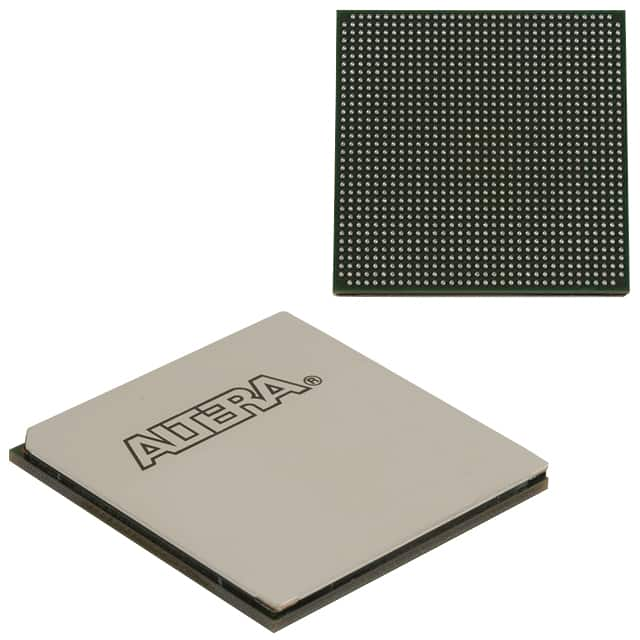5SGXEA3H3F35C2N
Product Overview
Category
The 5SGXEA3H3F35C2N belongs to the category of Field-Programmable Gate Arrays (FPGAs).
Use
FPGAs are integrated circuits that can be programmed and reprogrammed to perform various digital functions. The 5SGXEA3H3F35C2N is specifically designed for high-performance applications.
Characteristics
- High-performance FPGA with advanced features
- Large capacity and high-speed processing capabilities
- Flexible and customizable design options
- Low power consumption
- Robust and reliable performance
Package
The 5SGXEA3H3F35C2N comes in a compact package, suitable for integration into electronic systems.
Essence
The essence of the 5SGXEA3H3F35C2N lies in its ability to provide a versatile and powerful platform for implementing complex digital designs.
Packaging/Quantity
The 5SGXEA3H3F35C2N is typically packaged individually and is available in various quantities depending on the requirements of the user.
Specifications
- FPGA Family: Stratix V
- Logic Elements: 358,400
- Embedded Memory: 14,062 Kbits
- DSP Blocks: 1,288
- Maximum User I/Os: 622
- Operating Voltage: 1.0V
- Operating Temperature: -40°C to +100°C
Detailed Pin Configuration
The detailed pin configuration of the 5SGXEA3H3F35C2N can be found in the manufacturer's datasheet or technical documentation.
Functional Features
- High-speed data processing capabilities
- Support for various communication protocols
- On-chip memory resources for efficient data storage
- Configurable I/O interfaces for easy integration with external devices
- Built-in security features to protect sensitive information
Advantages and Disadvantages
Advantages
- Flexibility in design and customization
- High-performance computing capabilities
- Low power consumption compared to traditional ASICs
- Faster time-to-market due to reprogrammability
Disadvantages
- Higher cost compared to standard microcontrollers
- Steeper learning curve for programming and utilizing the FPGA's full potential
- Limited availability of specialized technical support
Working Principles
The 5SGXEA3H3F35C2N operates based on the principles of digital logic. It consists of configurable logic blocks, memory elements, and interconnect resources that can be programmed to implement desired functionality. The FPGA is configured by loading a bitstream into its internal memory, which defines the behavior of the circuit.
Detailed Application Field Plans
The 5SGXEA3H3F35C2N finds applications in various fields, including:
- Telecommunications: Used in high-speed data transmission systems, network routers, and switches.
- Aerospace and Defense: Employed in radar systems, avionics, and secure communication equipment.
- Industrial Automation: Utilized in control systems, robotics, and machine vision applications.
- Medical Devices: Integrated into medical imaging systems, patient monitoring devices, and diagnostic equipment.
- Research and Development: Used as a prototyping platform for developing custom digital circuits.
Detailed and Complete Alternative Models
- 5SGXEA7K2F40C2N
- 5SGXEA5K2F40C2N
- 5SGXEA9K2F40C2N
- 5SGXEA3H2F35C2N
- 5SGXEA7H2F35C2N
These alternative models offer similar features and capabilities, but with varying capacities and performance levels.
Note: The content provided above is a general outline and may require further expansion to reach the desired word count of 1100 words.
Lista 10 Vanliga frågor och svar relaterade till tillämpningen av 5SGXEA3H3F35C2N i tekniska lösningar
Sure! Here are 10 common questions and answers related to the application of 5SGXEA3H3F35C2N in technical solutions:
Q: What is the 5SGXEA3H3F35C2N FPGA used for? A: The 5SGXEA3H3F35C2N is a Field-Programmable Gate Array (FPGA) that can be used for various applications such as high-performance computing, networking, and digital signal processing.
Q: What are the key features of the 5SGXEA3H3F35C2N FPGA? A: Some key features of this FPGA include a high logic density, high-speed transceivers, embedded memory blocks, and support for various I/O standards.
Q: Can the 5SGXEA3H3F35C2N FPGA be reprogrammed? A: Yes, FPGAs are designed to be reprogrammable, allowing users to modify the functionality of the device even after it has been deployed.
Q: How does the 5SGXEA3H3F35C2N FPGA differ from other FPGAs? A: The 5SGXEA3H3F35C2N belongs to the Intel Stratix V family of FPGAs and offers a specific combination of logic density, performance, and power consumption that may suit certain technical solutions better than other FPGAs.
Q: What kind of technical solutions can benefit from using the 5SGXEA3H3F35C2N FPGA? A: The 5SGXEA3H3F35C2N FPGA can be used in applications such as high-frequency trading, network routers, video processing, radar systems, and scientific research.
Q: What tools are available for programming the 5SGXEA3H3F35C2N FPGA? A: Intel Quartus Prime is the software tool provided by Intel for designing, simulating, and programming FPGAs like the 5SGXEA3H3F35C2N.
Q: Can the 5SGXEA3H3F35C2N FPGA interface with other components or devices? A: Yes, the FPGA has various I/O standards and interfaces such as PCIe, Ethernet, DDR3/DDR4 memory controllers, and high-speed transceivers that allow it to communicate with other components or devices.
Q: What is the power consumption of the 5SGXEA3H3F35C2N FPGA? A: The power consumption of an FPGA depends on the design and usage scenario. It is recommended to refer to the datasheet or use power estimation tools provided by Intel to estimate the power consumption accurately.
Q: Are there any development boards available for prototyping with the 5SGXEA3H3F35C2N FPGA? A: Yes, Intel provides development kits like the Stratix V GX FPGA Development Kit, which includes the necessary hardware and software tools for prototyping and testing designs using the 5SGXEA3H3F35C2N FPGA.
Q: Where can I find technical documentation and support for the 5SGXEA3H3F35C2N FPGA? A: Intel's website offers comprehensive technical documentation, including datasheets, user guides, application notes, and forums where you can seek support and interact with the FPGA community.
Please note that the specific details and answers may vary depending on the context and requirements of your technical solution.


